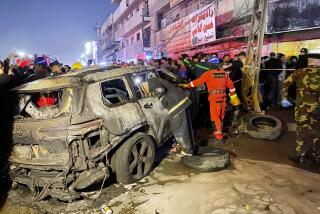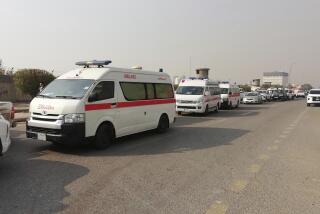U.N. Copter Attack Said to Aim at Aidid and Officers : Somalia: Several top militia leaders are reported killed. But the fugitive warlord had left the meeting site, U.N. officials say.
- Share via
NAIROBI, Kenya — Last Monday’s American helicopter assault on the command center of Somali warlord Mohammed Farah Aidid was timed to strike a morning strategy meeting of his top militia commanders, U.N. officials said Thursday.
The officials said that several of Aidid’s high-level guerrilla commanders were killed in the attack, carried out under the aegis of the U.N. command in Mogadishu in what officials there said was an effort to halt attacks on U.N. peacekeepers and restore security in the Somali capital.
Aidid had left the meeting earlier, after an appearance of just a few minutes. But among those killed were several of his top aides, who U.S. officials say may have organized an ambush June 5 that killed 24 Pakistani peacekeepers, according to the officials.
“We hit a key military planning cell of key Aidid advisers,” said retired U.S. Navy Adm. Jonathan Howe, the U.N. chief in Somalia, speaking by telephone from Mogadishu. “This is where they have made their plotting and planning for their terrorist attacks.”
Asked to confirm accounts from other U.N. officials that the U.S. attack was deliberately timed to strike during the meeting and kill Aidid’s chief lieutenants, Howe said: “We knew what we were hitting. It was well planned.”
The new details about the air strike--and the apparent targeting of militia commanders--came at a time of questioning of U.N. tactics.
Monday’s late-morning air strike also raised questions about whether the U.S. pilots in Somalia are now targeting people as opposed to places. Previous air attacks have occurred after midnight and in the pre-dawn hours as a way to minimize casualties, and sound trucks and loudspeakers have warned militiamen inside buildings to flee before the bombing began.
New details about Monday’s attack, including a Somali-made videotape supplied by Aidid’s supporters, show that the number of Somali casualties might be higher than the 13 killed that American officials conceded.
The International Committee of the Red Cross has said that at least 54 Somalis were killed in the attack and 174 wounded, based on a survey of two large local hospitals. But the actual casualty toll could be higher, since only two medical facilities were canvassed and since many Somalis traditionally bury their dead immediately without taking them to hospitals.
Howe, in the telephone interview from Mogadishu, said he believes the U.S. military count of 13 Somalis killed was accurate.
Howe also appealed Thursday for unity among the peacekeeping coalition, news agencies reported.
A diplomatic crisis has been brewing since Wednesday, when the United Nations demanded the removal of an Italian general for not following orders. Italy has also been at odds over U.N. handling of operations, especially a U.S.-led air strike on Aidid’s compound Monday.
On Thursday, Prime Minister Carlo Azeglio Ciampi hinted that Italy was ready to withdraw from Somalia. But Foreign Minister Beniamino Andreatta later reiterated Italy’s resolve to stay.
More to Read
Sign up for Essential California
The most important California stories and recommendations in your inbox every morning.
You may occasionally receive promotional content from the Los Angeles Times.










